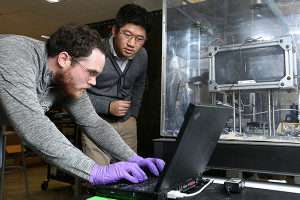Laser printing with nanoparticles holds promise for medical research

Electronic devices that can not only be implanted in the human body but also completely dissolve on their own – known as "bioresorbable" electronics – are envisioned by many as one of medical technology's next frontiers. A new study by Missouri University of Science and Technology researchers suggests that a laser printing technique using nanoparticles could help unlock a more cost-effective approach to building sturdier and safer components.
Writing in the journal Advanced Materials, the Missouri S&T researchers demonstrate a process to print tiny electronic components by using lasers to process print-ready zinc nanoparticles. The journal's authors include Dr. Heng Pan, assistant professor of mechanical and aerospace engineering at Missouri S&T, and Dr. Xian Huang, a professor of biomedical engineering at Tianjin University in China and a former S&T faculty member.
As Pan explains, bioresorbable electronics (also known as transient electronics) that use traditional microchip fabrication methods require costly optical patterning and vacuum deposition processes. Using laser printing is far more cost-effective ─ but potentially exposes zinc, magnesium and other necessary ingredients to oxygen, nitrogen and other ingredients that could cause adverse interactions.
The new process allows for zinc nanoparticles to be sintered together through an evaporation and condensation process that avoids surface oxides. The fabricated, oxide-free zinc conductors demonstrated high electrical conductivity, mechanical durability and water dissolvability, the researchers report.
"The new method can direct-print patterned zinc conductors on bioresorbable polymers with conductivity close to bulk values," Pan says. "And the fabricated patterns on bioresorbable substrate can be readily integrated with high performance electronics."
Pan's research interests also include the field of stretchable electronics, which can be bended or folded to allow users to wear sensors on their clothing or directly on the skin.
More information: Wan Shou et al. Low-Cost Manufacturing of Bioresorbable Conductors by Evaporation-Condensation-Mediated Laser Printing and Sintering of Zn Nanoparticles, Advanced Materials (2017). DOI: 10.1002/adma.201700172


















